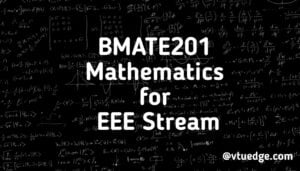
BMATE201 Mathematics for EEE Stream
Syllabus Copy
Module - 1
Vector Calculus
Introduction to Vector Calculus in EC & EE engineering applications. Vector Differentiation: Scalar and vector fields. Gradient, directional derivative, curl and divergence – physical interpretation, solenoidal and irrotational vector fields. Problems. Vector Integration: Line integrals, Surface integrals. Applications to work done by a force and flux. Statement of Green’s theorem and Stoke’s theorem. Problems. Self-Study: Volume integral and Gauss divergence theorem. Applications: Conservation of laws, Electrostatics, Analysis of streamlines and electric potentials.
Module - 2
Vector Space and Linear Transformations
Importance of Vector Space and Linear Transformations in the field of EC & EE engineering applications. Vector spaces: Definition and examples, subspace, linear span, Linearly independent and dependent sets, Basis and dimension. Linear transformations: Definition and examples, Algebra of transformations, Matrix of a linear transformation. Change of coordinates, Rank and nullity of a linear operator, Rank-Nullity theorem. Inner product spaces and orthogonality. Self-study: Angles and Projections.Rotation, reflection, contraction and expansion. Applications: Image processing, AI & ML, Graphs and networks, Computer graphics.
Module - 3
Laplace Transform
Importance of Laplace Transform for EC & EE engineering applications. Existence and Uniqueness of Laplace transform (LT), transform of elementary functions, region of convergence. Properties–Linearity, Scaling, t-shift property, s-domain shift, differentiation in the sdomain, division by t, differentiation and integration in the time domain. LT of special functionsperiodic functions (square wave, saw-tooth wave, triangular wave, full & half wave rectifier), Heaviside Unit step function, Unit impulse function. Inverse Laplace Transforms: Definition, properties, evaluation using different methods, convolution theorem (without proof), problems, and applications to solve ordinary differential equations. Self-Study: Verification of convolution theorem. Applications: Signals and systems, Control systems, LR, CR & LCR circuits.
Module - 4
Numerical Methods -1
Importance of numerical methods for discrete data in the field of EC & EE engineering applications. Solution of algebraic and transcendental equations: Regula-Falsi method and Newton-Raphson method (only formulae). Problems. Finite differences, Interpolation using Newton’s forward and backward difference formulae, Newton’s divided difference formula and Lagrange’s interpolation formula (All formulae without proof). Problems. Numerical integration: Trapezoidal, Simpson’s (1/3)rd and (3/8)th rules(without proof). Problems. Self-Study: Bisection method, Lagrange’s inverse Interpolation, Weddle’s rule.Applications: Estimating the approximate roots, extremum values, area, volume, and surface area.
Module - 5
Numerical Methods -2
Introduction to various numerical techniques for handling EC & EE applications. Numerical Solution of Ordinary Differential Equations (ODEs): Numerical solution of ordinary differential equations of first order and first degree – Taylor’s series method, Modified Euler’s method, Runge-Kutta method of fourth order and Milne’s predictorcorrector formula (No derivations of formulae). Problems. Self-Study: Adam-Bashforth method. Applications: Estimating the approximate solutions of ODE for electric circuits.
you got a very superb website, Gladiola I found it through yahoo.